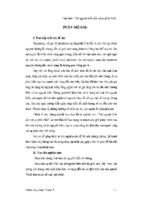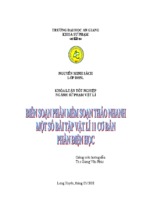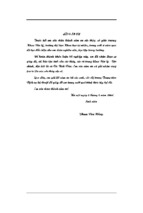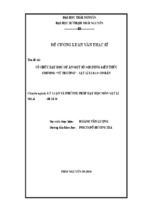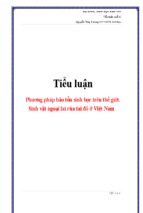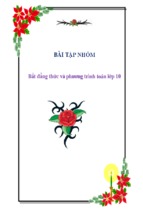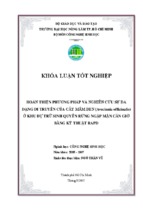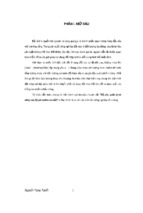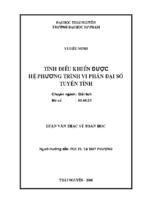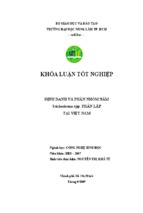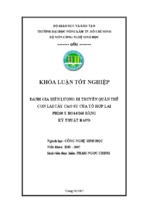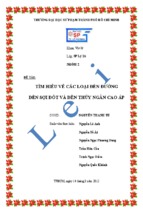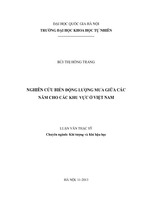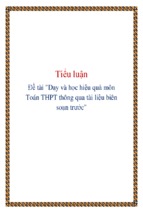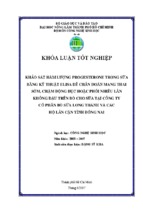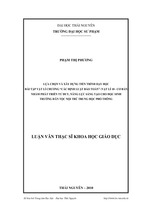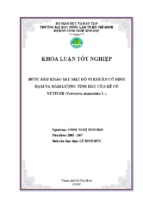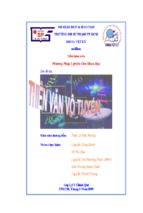[Type text]
BUSINESS RESEARCH PROJECT
THE FACTORS AFFECTING
CUSTOMERS’ LOYALTY TO
SUPERMARKETS IN HO CHI MINH CITY
Student:
PHAM THANH TUAN
ID No:
CGSVN00015023
Class :
MBAOUM0313 -K80A
Advisor:
A.PROF. NGUYEN PHAN
June 2014
Business Research Methods – BMBR5103
Page 1
[Type text]
Advisor’s assessment
.....................................................................................................................................................................
.....................................................................................................................................................................
.....................................................................................................................................................................
.....................................................................................................................................................................
.....................................................................................................................................................................
.....................................................................................................................................................................
.....................................................................................................................................................................
.....................................................................................................................................................................
.....................................................................................................................................................................
.....................................................................................................................................................................
.....................................................................................................................................................................
.....................................................................................................................................................................
.....................................................................................................................................................................
.....................................................................................................................................................................
.....................................................................................................................................................................
.....................................................................................................................................................................
.....................................................................................................................................................................
.....................................................................................................................................................................
.....................................................................................................................................................................
.....................................................................................................................................................................
.....................................................................................................................................................................
.....................................................................................................................................................................
Advisor’s signature
Business Research Methods – BMBR5103
Page 2
[Type text]
TABLE OF CONTENT
CHAPTER 1:INTRODUCTION……………………………................................5
1.1 Reasons for research…………………………………………………………….5
1.2 Research questions………………………………………………………………6
1.3 Research goals…………………………………………………………………...6
1.4 Subject and scale of research……………………………………………………6
1.5 Research methodology…………………………………………………………..7
1.6 Contributions of this research…………………………………………………..7
1.7 Thesis structure………………………………………………………………….7
CHAPTER 2: THE RETAIL MARKET ……………..……………………...…..9
2.1 Revenue from retail and consumer services throughout the years…… ..……..9
2.2 The market for main types of retail goods……………………...…………...…..9
2.3 Overview of the competition situation among supermarkets in Vietnam….....12
CHAPTER 3: THEORETICAL BASES……………………...…………..…….14
3.1 Supermarket Theories…………………………………………………...……..14
3.2 Service theories…………………………………………………...……………15
3.3 Loyalty theories……………………………………………………………......18
3.4 Overview of previous researches……………………………………………...21
3.5 Proposed research model……………………………………………………....23
CHAPTER 4: STUDY DESIGN……………………………..……..…...………28
4.1 Research Process………………………………………………………..……..28
4.2 Qualitative Research……………………………………………..……………28
4.3 Qualitative Research …………………………………………………………..29
Business Research Methods – BMBR5103
Page 3
[Type text]
4.4 Scale……………..…………………………………………………………….31
CHAPTER 5: RESEARCH FINDINGS……………..………………………....36
5.1 Descriptive Statistics………………………………………………..………....36
5.2 Testing the model …………………………………………………..………....44
5.3 Regression Analysis…………………..……………………………………….59
5.4 Seeking violation…………………………………..………………………..…66
5.5 Testing the difference between groups………………………………………..66
5.6 Regression analysis based on frequent supermarkets ……………………......72
CHAPTER 6: CONCLUSION AND SUGGESTIONS FOR MANAGERS…..78
6.1 Conclusion……………………………..………………………………………78
6.2 Implication for manager…………….…..……………………………………...79
6.3 Limitations of the subject and directions for further research…………..……82
REFERENCE MATERIAL ……………..…………………………………...….. 83
APPENDIX 1 –INTERVIEW OUTLINE…………………………………..……..87
APPENDIX 2 – SURVEY QUESTIONAIRE………..………………………...…92
APPENDIX 3 – PREMILINARY RESEARCH……………………………..……93
APPENDIX 4 – EFA ANALYSIS…………………………………………….….102
APPENDIX 5 – REGRESSION ANALYSIS………………………………..…..107
APPENDIX 6 – VIOLATION SEARCH……………………………….…..…....109
APPENDIX 7 – DIFFERENCE INSPECTION………………………...…….….110
Business Research Methods – BMBR5103
Page 4
[Type text]
CHAPTER 1: INTRODUCTION
1.1 Reasons for research
In the emerging trend to integrate with the world’s economy, business fields in
Vietnam in general and the retail industry in particular are not only facing fierce
competition from fellow domestic firms but are also under pressures from foreign
companies. On January 1st, 2009, compelled to its commitments to joining the
World Trade Organization – WTO, Vietnam officially opened the door to its retail
market for foreign investors, making the competition in the retail market become
fiercer than ever.
Along with the existing domestic supermarket chains, the market for retailing
supermarkets in Vietnam in general and in Ho Chi Minh City in particular is
becoming more vibrant, and the level of competition is becoming fiercer by the day.
To survive and to thrive, domestic firms have to continuously increase their
standards of quality, diversify their goods, upgrade and modernize their
infrastructures, and widen their food and goods distribution network in order to
compete with supermarket chains run by foreign corporations. Increasing the
number of loyal customers’ visit to its supermarket chain is an urgent matter for a
firm because according to Kotler (2011), the cost to attract a new customer is
usually nine to ten folds that to maintain an existing customer. It is worth noting
that, as the competition on the market becomes more and more complex, to survive
and prosper, supermarket administrators have to find ways to establish and increase
their customers' loyalty. Building customer loyalty plays an important role in
building a firm's competitive strategies, which is even more crucial as top-tier
retailers worldwide such as Tesco, Walmart, Carrefour, etc. have been making
preparations to set foot on the market. According to Nguyen Thi Mai Trang (2006),
customers’ loyalty to a supermarket is the most important factor deciding that
supermarket’s success and existence. Without customer loyalty, the competitive
strength of a firm will be negligible. With the purpose of helping supermarket
Business Research Methods – BMBR5103
Page 5
[Type text]
administrators understand more clearly the importance of customer loyalty in mind,
the authors chose the topic “The factors affecting customers’ loyalty to
supermarkets in Ho Chi Minh City” to be the research subject for their research.
1.2 Research questions
This thesis focuses on researching to answer these questions:
(1) Which factors will affect the loyalty of customers to supermarkets in Ho Chi
Minh City?
(2) To what extent do these factors affect the loyalty of customers to
supermarkets in Ho Chi Minh City?
(3) Are there any differences among the loyalty of different types of customers
to supermarkets in Ho Chi Minh City?
1.3 Research goals
To answer the questions stated above, the specific goals of this thesis are to:
(1) Point out the factors affecting customer loyalty towards supermarkets in Ho
Chi Minh City?.
(2) Measure the extent to which the factors affect the loyalty of customers
towards supermarkets in Ho Chi Minh City?.
(3) Explore the differences among survey subjects in their loyalty towards
supermarkets in Ho Chi Minh City?.
1.4 Subject and scale of research
This research is conducted using the method of directly surveying the opinions
of regular supermarket shoppers in Ho Chi Minh City. Samples are chosen using the
convenience sampling method. The data used for research are mainly primary data,
collected from handling questionnaires directly to customers.
Business Research Methods – BMBR5103
Page 6
[Type text]
1.5 Research methodology
This thesis researches the factors affecting the loyalty of customers when
visiting supermarkets in Ho Chi Minh City in two steps:
Step one: Conducting qualitative research through one-on-one discussions with
regular supermarket customers, based on the interview draft in June 2013.
Customers will adjust the use of words in the questions to clarify them as well as
adding statements to clarify the research concept. From the result of this qualitative
research, combined with the theoretical base, the official measuring scale for this
research is built.
Step two: Conducting quantitative research through handling close-ended
questionnaires directly to 700 customers regularly visiting supermarkets such as Coopmart, Big C, Maximart…in Ho Chi Minh City; collecting 506 legitimate finished
questionnaires in July 2013.
1.6 Contributions of this research
The research “The factors affecting customers’ loyalty to supermarkets in
Ho Chi Minh City” helps supermarket administrators gain necessary information
and acknowledge the importance of factors affecting the loyalty of customers. From
there, the administrators can come forth with solutions to maintain customers’
loyalty.
1.7 Thesis structure
Chapter 1: Research overview
This chapter states the reason for choosing this topic, the research questions,
research goals, subject and scale of research, research methodology, and the
contributions of this research and the structure of the thesis.
Chapter 2: The retail market and the competition situation among
supermarkets in Vietnam.
Business Research Methods – BMBR5103
Page 7
[Type text]
The second chapter introduces the revenue from retail and consumer services
throughout the years, the market for main retail goods, and the overview of the
competition situation among supermarkets in Vietnam.
Chapter 3: Theoretical bases
The content of this chapter presents the definition of supermarket, supermarket
classifications, theories on service, theories on loyalty and the summaries of
previous researches. Finally, the author argues the research hypotheses to propose
the initial research model.
Chapter 4: Research design
This chapter presents the research subjects, the survey subjects, the sampling
methods, the analytical methods and the designing of the measuring scale to form
the survey questionnaire.
Chapter 5: Research results analysis
Chapter five uses the descriptive statistics method, the Cronbach Alpha internal
consistency analysis method, the explanatory factor analysis method, and the
regression analysis method, to detect violations and verify the differences.
Chapter 6: Conclusions and notes to administrators:
From the conclusions drawn from the research results, this thesis puts forth
recommendations for supermarket administrators/managers in order to increase
customer loyalty.
Business Research Methods – BMBR5103
Page 8
[Type text]
CHAPTER 2: THE RETAIL MARKET AND THE COMPETITION
SITUATION AMONG SUPERMARKETS IN VIETNAM
Chapter two introduces the revenue from retail and consumer services
throughout the years, the market for main retail goods, and the overview of the
competition situation among supermarkets in Vietnam.
2.1 Revenue from retail and consumer services throughout the years
The revenue gained from retail and consumer services maintained a high degree
of growth in the period 2005-2011, increasing at an average of up to 27%/year. The
total amount of goods sold in retail and revenue from consumer services in 2011 in
Vietnam were estimated to be 2,004.4 trillion dong (approximately 96 billion USD),
having increased by 24.2% compared to the previous year; if excluding the price
factor, the increase was 4.7%. If calculated based on the proportion of contributing
components, the majority of the retail revenue came from the individual and private
sectors, which accounted for 85% of the total retail revenue. This showed the
activeness of these business groups. The revenue from the government sector in
2010 was 219 trillion dong, making up 11% of the total revenue from retailing and
service providing. The proportion of revenue from the FDI companies sector is
quite low at 3% of the 2010 total retail revenue. As of the speed of growth in the
period 2005-2011, the average retail revenue growth rate for the individual and
private sectors were 23% and 38%/year, respectively, while that of the FDI
companies sector was 21%/year, lower than the average rate at 27%/year.
(www.gso.gov.vn)
2.2 The market for main types of retail goods
2.2.1 Food and beverages
Food is the most important segment of the retail market. In 2011, the proportion
of spending for food in the total retail expense in Vietnam was up to 62.5%, higher
than that of China (60.7%), Thailand (58.1%) and Indonesia (59.8%). In Vietnam,
80% of the retail outlets are food outlets (www.vneconomy.vn). Moreover, food
Business Research Methods – BMBR5103
Page 9
[Type text]
outlets are usually stationed in numbers in traditional markets and in unlicensed
stalls. In the trend of urbanization and modernization of the economy, supermarkets
and food stores appear more often than before. In general, the cuisine needs of
Vietnamese people are becoming more diverse and increase alongside the
population growth scale. However, under the effects of inflation, the proportion of
spending for food in the total income of people is increasing.
Consumer food revenue in Vietnam in 2011 reached 357 trillion dong
(approximately 18.69 billion USD), 1.9 times higher than that in 2006. The
consumer revenue from food in 2012 was estimated to be 397 trillion dong
(equivalent to 19.3 billion USD), which was a 3 percentile increase compared to the
figure in 2011 (www.gso.gov.vn). Compared to the scale of the population, the
average amount of spending for food per capita in Vietnam in 2011 reached 4
million dong/person (equivalent to 212.7 USD/person), which was a 1.8 times
increase compared to that in 2006. Therefore, the yearly average food consumption
growth rate in Vietnam was about 12%. Compared to other Asian countries, this
average spending on food per capita was relatively low. This was a significant
growth potential for the food industry (www.saigontimes.com.vn).
As of breweries, the need for breweries in Vietnam is very significant. Aside
from the reason that Vietnam is in a tropical location with a hot and humid climate,
there are two other important reasons: that the majority of the population are in their
young and working years, and the living culture of Vietnamese people. The total
revenue from alcoholic drinks in 2011 reached 1.7 billion USD, an 18.46%
improvement compared to the previous year. The total volume of alcoholic drinks
consumed in 2011 in Vietnam was 2.1 billion liters, which composed of 2 billion
liters of beer and 16.3 million liters of table wine. Therefore, beer was the dominant
kind of goods in the Vietnamese breweries market. Aside from alcoholic drinks, the
need for non-alcoholic drinks in Vietnam is also great. The revenue from nonalcoholic drinks in 2011 reached 1.7 billion liters, equivalent to 6,430 billion dong,
Business Research Methods – BMBR5103
Page 10
[Type text]
which was a 20.37% increase in volume and a 15.98% increase in worth compared
to the previous year. (www.saigontimes.com.vn).
Coffee is also a drink which is greatly interested in and favored in Vietnam.
The total coffee sales revenue in 2011 in Vietnam reached 39.8 thousand tons.
Vietnam also owns several famous coffee brand names such as Trung Nguyen,
Vinacafe Bien Hoa (VCF). As of the foreign investors group, Nestlé took the top
spot in the instant coffee segment. (www.sgtt.com.vn)
2.2.2 Consumer goods
As of household appliances, this industry is split into two segments: large
appliances (washing machines, air conditioners, TV, refrigerators, etc.) and small
appliances (fans, irons, blenders, coffee makers, etc.). The total sale of household
appliances in 2011 reached 14.2 million units, 9.4 million of which was of small
appliances and 4.7 million was of large appliances. Therefore, the average growth
rate for the sales of household appliances in the period 2006-2011 reached
12.5%/year, in which the sales of small appliances increased by 10.5%/year and that
of large appliances increased by 17.5%/year. Calculated base on worth, the revenue
from household appliances in 2011 in Vietnam was 30.882 billion dong, in which
small appliances contributed 11.063 billion dong and large appliances contributed
19.819 billion dong. The average growth rate for household appliances in the period
2006-2011 was 21.1%, in which large appliances revenue grew by an average of
20%/year and the revenue of small appliances grew by an average of 21.7%/year
(www.vneconomy.vn).
Calculated based on the market share (based on sales) of large household
appliances suppliers, Sanyo took the largest market share in 2010 at 49.8%,
followed by LG (9.7%), Toshiba (6.5%), Panasonic (4.8%), Electrolux (4.7%), etc.
As of the market share of small appliances suppliers, Phillips took the largest share
in 2010 at 21.3%, followed by Sharp at 17%, Panasonic at 15.7%, etc.
(www.sgtt.com.vn)
Business Research Methods – BMBR5103
Page 11
[Type text]
As of personal belongings, this branch is usually about clothing, jewelry
accessories, etc. Even though Vietnam is an exporter of garment goods, as the life
quality of the people increased and the process of globalization and integration
became more rapid, Vietnamese people in the medium segment and above have the
tendency to pay more attention to famous brand names from foreign countries such
as Mango, Bossini, Gucci, D&G, Valentino, etc. Moreover, most popular brand
names like Bossini, Mango and Giordano have their products made in China so they
can be sold in major cities in Vietnam at affordable prices. It has been estimated
that the total revenue from garment products in 2011 in Vietnam reached about 2.5
billion USD, an 18% increase compared to 2010 (www.saigontimes.com.vn)
2.3 Overview of the competition situation among supermarkets in Vietnam
Despite having fallen out of the top 30 countries most favorable for the retail
business as well as being under the effects of a struggling economy, Vietnam still
has a retail market considered potential for investors to exploit. In an assessment on
the retail market, the Ministry of Industry and Commerce commented, after five
years of joining the World Trade Organization, the retail industry in Vietnam has
expanded at a fairly fast pace, having establish its presence on the market and
fulfilled the needs of the people. The number of newly established supermarkets in
this period increased by more than 20%. The number of commercial malls formed
anew also increased by more than 72%. Moreover, distributed over the country are
thousands of specialized stores and convenience stores (after the modern business
model of advanced countries). Generally estimated, the market share of the types of
modern retail models is about 20% of all the retail industry, twice that at the time
they were initially introduced. Statistically, there are 717 modern retail stores all
over the country and 8,600 traditional markets. The official administrators of retail,
the Ministry of Industry and Commerce, wanted that by 2020, there would be 1200
supermarkets, 157 shopping centers and 180 commercial malls. By then, the
proportion of modern retailing in the retail industry would reach 43%
Business Research Methods – BMBR5103
Page 12
[Type text]
(www.vnexpress.com.vn). The following statistics will prove the growth of the
distribution network of supermarkets:
The Korean corporation of Lotte planned to develop 60 supermarkets and
commercial malls in Vietnam, starting with Lotte Mart (opened in July 24) and
hiring a whole 4 commercial floors (about 20,000 m2) of Mipec Mall.
The Japanese company, Aeon, had plans to open two commercial complexes every
year in Vietnam until they reach 20 complexes in 2020.
The French Big C chain of supermarkets has had 20 supermarkets in Vietnam, but is
still working on developing their system by opening a center in Phu Tho and
building a complex in Quang Ninh.
The Ocean Group is making their first investment moves in the retail industry.
Ocean Retail, a member of Ocean Group, who is in charge of and is developing the
OceanMart supermarket chain, stated that their plan is to open 70-80 supermarkets
and commercial malls across the country by 2015, making retailing the strategic
direction of the corporation.
Coopmart is running three parallel business models serving different target
customers including Coop Extra (giant supermarkets), Coop Food and the
supermarket chain of Coopmart. Among those models, Coopmart has 65
supermarkets including 27 supermarkets in Ho Chi Minh Cityand 38 supermarkets
in other major provinces and cities across the country.
Coopmart’s goal is to expand to 100 supermarkets by 2015, meaning each year
Saigon Coop has to open 10 new supermarkets.
The supermarket chain of Vinatex Mart, belonging to the Vietnam National Textile
and Garment Group, is also expanding their list of supermarkets and retail stores,
with 21 supermarkets across many provinces and cities. Their newest conquers are
in Bac Lieu and My Tho.
The supermarket chain of Citimart has also raised the number of their supermarkets
in residential and urban areas to 18.
Business Research Methods – BMBR5103
Page 13
[Type text]
The corporation of Metro Cash & Carry, with their revenue at 1.7 trillion dong/year
has also committed to deploy fully and quickly their 8 distribution centers across the
country, from Ho Chi Minh City, Ha Noi, Hai Phong, Can Tho, Da Nang and with
the Tay Nguyen market in sight. (www.vietbao.vn)
The figures above have shown the fierce competition among supermarkets.
Therefore, loyalty to a supermarket is the most important factor, deciding said
supermarket’s successes and existence. Without customers’ loyalty, the competitive
power of a supermarket will be insignificant. Therefore, doing research on the
factors affecting the loyalty of customers towards supermarkets is a necessary and
highly practical thing to do.
CHAPTER 3: THEORETICAL BASES
The content of this chapter presents the definition of supermarket, supermarket
classifications, theories on service, theories on loyalty and the summaries of
previous researches. Finally, the author argues the research hypotheses to propose
the initial research model.
3.1 Supermarket Theories
3.1.1 Supermarket Definition
Supermarket is a kind of modern store, selling general or specialized goods,
with a diverse range of merchandise. The types of goods being sold may not be
related to each other (in general supermarkets) or they can belong to a same type of
merchandise (in specialized supermarkets). These merchandises are ensured to be of
good quality and follow specific quality standards. Supermarkets must meet
standards on their business areas, technical equipment, management and business
organization, and they must possess civilized and convenient service procedures in
order to satisfy customers’ shopping needs. Supermarkets may be general or
Business Research Methods – BMBR5103
Page 14
[Type text]
specialized but may not include such services as meeting halls, meeting rooms,
offices, etc. (supermarket – commercial mall regulations, 2004)
3.1.2 Supermarket Classification
Class I supermarket: Aside from standards requiring modern infrastructures,
warehouses, preservation techniques, hygiene areas and entertainment areas,
general supermarkets must comply to these basic standards: having a
business area from 5000 m2 or more, having an inventory with 20,000
merchandise names or more. For specialized supermarkets: the basic
standards are: having a business area of 1000 m2 or more and an inventory of
2,000 merchandise names or more.
Class II supermarket: General supermarkets must comply to these basic
standards: having a business area from 2,000 m2 or more and an inventory
with 10,000 merchandise names or more. With specialized supermarkets, the
basic standards are: having a business area from 500m2 or more and an
inventory with 1,000 merchandise names or more.
Class III supermarket: General supermarkets must comply to these basic
standards: having a business area from 500 m2 or more and an inventory with
4,000 merchandise names or more. With specialized supermarkets, the basic
standards are: having a business area from 250m2 or more (like a general
supermarket) and an inventory with 500 merchandise names or more.
(supermarket – commercial mall regulations, 2004)
This research focuses on analyzing the factors affecting customers’ loyalty
towards class I supermarkets. These are the supermarkets mentioned in the survey
questionnaire including Coopmart, Big C, Maximart, Lottemart and Citimart.
3.2 Service theories
3.2.1 Service definition
Groonroos (1990), referred to by Kang and James (2004) defined service as an
activity or a chain of activities with more or less intangibility, in which there are
Business Research Methods – BMBR5103
Page 15
[Type text]
interactions between customers and customer service staffs, material resources,
goods or service providing systems.
Kotler (2011) defined service as an activity or a benefit that one partner can
provide the other partner, which has intangible characteristics and does not
associate with any transfer of possession.
However, nowadays, there is no accurate and unified definition of service. Pure
services have some features to differentiate itself from pure merchandise. These
differences lead to the fact that providing a service is different to provide
merchandise in terms of intangibility, the inseparability between providing and
consuming services, non-uniformity, non-storability and the inability to transfer
possession.
3.2.2 Service characteristics
According to Zeithaml et al (1985), the service industry is considered the part
that provides an economy’s intangible values. Services have some distinctive
characteristics that we can base on to differentiate them with other tangible goods,
which are these five aspects:
Intangibility: A service’s intangibility is its inability to be touched or
grasped; it does not have a specific form like a tangible product. Therefore, to lower
uncertainty, buyers seek proofs of quality from the objects they come in contact
with or the equipments that they can see.
Inseparability: This characteristic is the difficulty in differentiating the
creation and the consumption of a service. A service cannot be separated into the
creation phase and the consumption phase. The creation and consumption of most
service happen simultaneously, because the customer will also be present at the
provision of the service so the interaction between the service provider and the
customer is a special characteristic of services.
Non uniformity: a service’s different levels of accomplishment, which
means that a service can be either rated very bad or very perfect. The essentials and
Business Research Methods – BMBR5103
Page 16
[Type text]
quality of a service may change according to the provider, the perception of the
customer and the time of service. Basically, fluctuations in services happen easily
and they happen more regularly compared to the fluctuations in tangible products,
because in services there is a high level of human interaction. This makes
standardizing services even more difficult.
Non-storability: services only exist at the time of provision; therefore they
cannot be produce en masse for storage. They are only sold when there is a demand
on the market and that demand is hard to predict. The demand can change according
to seasons, the times in a day, business circles, etc.
The inability to transfer possession: Upon buying a product, the customer
is granted its possession and will become the owner of the product they bought.
When buying a service, the customer can only uses the service, enjoy the benefits it
brings during a limited period of time. This characteristic affects distribution
policies in which intermediaries, both retailer and wholesalers are not transferred
possessions. They are merely taking part in the provision of the service.
3.2.3 Service quality definition
Customers play a very important role in services; therefore, when assessing a
service, people usually mention the two concepts: “service quality” and “customer
satisfaction”. Service quality is the issue most concerned about by managers these
days in business. A good quality product may not be chosen by customers if the
services that go with it are judged as of low quality. Nowadays there are numerous
different definitions of service quality, but in general service quality is defined as
what customers can feel. Each customer has different perceptions and demands so
the feeling they have about the service quality they received will also be different.
Juran (1988), referred to by Luu Van Nghiem (2008) stated that quality is the
fitness for purpose. Feigenbaum (1991) defined quality as the decision of customers
based on their actual experiences with a product or service, measured based on the
requirements of that customer. These requirements may be stated or not, be
Business Research Methods – BMBR5103
Page 17
[Type text]
perceived or simply felt, be purely subjective or have some degrees of expertise and
always represent variable targets in a competitive market. Meanwhile, Russell
(1999), referred to by Kang and James (2004) stated that quality represents the
superiority of a product or service, especially if they reach a level that can satiate
every demands of customers and please them.
According to Ranaweera and Neely (2003), service quality has to be assessed
based on two aspects that are the service provision and the service results. Gronroos
(1984) also proposed two aspects of service quality including the technical quality
and the usability quality. Technical quality involves what are being served and
usability quality involves the way services are delivered. However, researches done
by Parasuraman et al (1985, 1988) stated that service quality is an all rounded
assessment of the attitude that aims at service excellence.
3.3 Loyalty theories
3.3.1 Loyalty definition
The loyalty of customers is an important factor in the customer strategy of any
company. Increasing customer loyalty is becoming a heated topic among managers,
consultants and scholars. Loyalty is also defined as the deep commitment to
repurchase a favorite product or service in the future, therefore exists the repeated
purchasing of a single brand or a group of brands, even though that can be changed
by effects from marketing efforts. (Oliver, 1999 referred to Yee et al, 2010).
According to Oh (1995), referred to by Kim et al (2004), there are three main
methods to approach loyalty for research: The first one is the activities including
customer information sharing, the frequency of visit, the cross purchasing level and
the durability of the relationship; the second way includes personal interests,
commitments, intentions and finally integration. (Rittippant et al, 2009). The
suitable approaching method includes both variables “activity” and “attitude” to
create a unique definition of loyalty. The definitions of loyalty of customers can be
understood as a combination of the attitude of enjoyment from customers and the
Business Research Methods – BMBR5103
Page 18
[Type text]
repurchase activities (Kim et al, 2004). The loyalty of customers towards a retail
store is that a customer keeps purchasing again and again from a specific store
(Rittippant et al, 2009). Many researches showed that loyal customers buy more,
pay higher prices and refer the store to other customers.
Hart (1999)identified that in order to gain customer loyalty, companies must
continuously provide superior values to customers that lead to an increase in market
share and profit, and decrease the cost to attract a new customer (Rittippant et al,
2009). Kumar and Shah (2004) stated that loyal customers can be a double edged
blade. If poorly managed, they can seriously harm a company. This is where profit
that can harm loyalty. But if the loyalty of customers is carefully managed in
accordance with profit, loyalty can become the mightiest marketing weapon against
competitors.
3.3.2 Competitive advantages from loyalty
Griffin (2002) assumed that gaining more loyalty brings a number of
competitive advantages to a company, as stated below:
Loyal customers actively choose to purchase again and again from a single
company, thus reducing the market share of its opponents.
Loyal customers are price insensitive and therefore will not react to discount
campaigns from the company’s opponents.
Loyal customers allow a company chances to make competitive offers or to
correct mistakes made during the service provision process before giving up
on the company.
Having a large loyal customer base helps a company reduce its marketing
cost used to attract new customers.
The loyalty of customers is considered a mean to stop customers from
switching to another competing company or brand (Cant and Toit, 2012)
3.3.3 Impacts of loyalty on companies’ profit
Business Research Methods – BMBR5103
Page 19
[Type text]
Griffin (2002), referred to by Cant and Toit (2012) suggested a number of
important ways through which the loyalty of customers can increase a company’s
profit:
Marketing cost reduction: The marketing cost for a loyal customer can be
lowered since the cost to keep a customer interested is lower than that to
obtain a new customer. Gaining a new customer implies that a lot of
promotion campaigns and customer-aimed multimedia usage are needed.
Therefore it costs more compared to the cost to retain an existing customer.
When using a lower marketing budget, companies can focus more on
improving their product quality.
Low transaction cost: loyal customers tend to be price insensitive; therefore
they are not easily moved by the marketing efforts of competing opponents.
Thus, when trading with loyal customers, it is not necessary that a company
negotiates the terms on the price, the delivery service or the packaging of
products, but they should focus more on maintaining and expanding
relationships. This reduces transaction costs.
Lower customer attraction cost: Having a new customer after they walk away
due to dissatisfaction is costly and requires a lot of marketing effort. By
keeping existing customers satisfied and loyal, a company can reduce the
cost commonly needed to obtain a new customer.
Increase cross selling: since loyal customers have a certain level of
familiarity with a company and its line of products, the company can more
easily conduct the cross selling of relating items. When customers buy more
products, the company gains more benefits and increases the switching cost
of customers.
Lower error cost: In their relationship, both the company and its customers
do researches to act in a certain way and expect a certain level of service
quality as well as respect from the other party. This reduces the error cost or
mistakes during the provision of services.
Business Research Methods – BMBR5103
Page 20
- Xem thêm -



